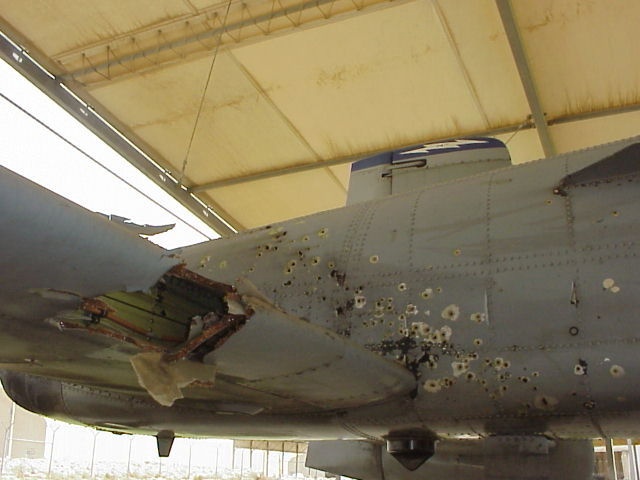
Posted on 11/21/2007 4:33:45 PM PST by Jet Jaguar
SPANGDAHLEM, Germany – Tracking and pursuing enemy forces on the ground should be easier for A-10 pilots with the 81st Fighter Squadron when they go downrange early next year.
By the time they deploy, leaders hope the unit’s 18 aircraft will be outfitted with new targeting systems. Three already have been installed with six more on the way.
The technology allows pilots to deploy laser-guided munitions, pursue moving targets at night with infrared imaging and stabilize points on the ground while maneuvering. The information is routed from a targeting pod attached under the wing to a monitor in the one-man cockpit. Ground forces also have access to the images coming from the plane.
“It’s like a super-powered binocular,” said 1st Lt. Stephen Bowen, who will be deploying for the first time with the unit. It is still unknown where the squadron will be sent.
But Bowen and the other pilots are learning to use the new systems with caution.
It’s apparently easy to get caught up watching the tracking screen, jokingly referred to as the “drool cup.” So pilots are learning to strike a balance between using the targeting system and their tried-and-true technique of simply looking out the window.
Watching the monitor too much can be dangerous because “it’s like looking through a soda straw,” Bowen said. “It’s a very limited field of vision … In some cases, it’s better not to use it at all.”
The unit just got back to Spangdahlem after a seven-week training mission at MacDill Air Force Base in Tampa, Fla. There they worked with the new targeting technology and participated in two close-air support exercises with the U.S. Army, Navy and Marines, and British forces.
The scenarios allowed the unit the rare opportunity “to integrate with all the different assets,” said Maj. Mark Lambertsen, the unit’s second in command.
Built to operate near the front lines, the A-10 can fly at low air speeds and altitude. It can survive direct hits from armor-piercing and high explosive projectiles up to 23 mm. Pilots are protected by titanium armor that also protects parts of the flight-control system.
Close-air support missions are expected to be the unit’s primary focus downrange, Lambertsen said.
“The toughest part is keeping track of all the moving parts to make sure everyone’s de-conflicted and to maintain situational awareness,” he said.
The key to close-air support is “finding the fine line between trying to support them with air power and to do things fast without messing up,” Lambertsen said. “We can’t afford any mistakes.”

God Bless John Boyd.
I love the A-10. When you really, really have to kill something right away, there is your aircraft.
Additionally, what’s not to love about bomblets?
The A-10 is one plane that needs to go back into production.
The 10s with the shark mouth are Conn ANG
Is that “party mix” being loaded?
It made for a hell of a cheap and reliable ground attack plane.
And lots of spare engine parts.
Yup! 30mm U235 specials.
Smokin'!:

As part of this last A-10 upgrade the engine pylons were changed. They are hoping “funds become available soon for engine upgrades.” Translated: “if the ‘rats don’t win the A-10 engine upgrade is possible.”
coming soon to a television near you....
You know it.
The A-10 is an amazing, enigmatic aircraft. If you talk to the US ground forces, they first ask why we don’t have armadas of A-10s to blanket the battlefield and wreak havoc on their enemy. Then they ask why don’t we make drone A-10s to do that.
And if the answer to the first question is complicated, the answer to the second one is paradoxical.
That is, as part of its design, as much of the A-10 as possible has redundant systems. This means, and has been proven, that in combat, an A-10 can take an unbelievable amount of punishment and still return home. Aircraft missing big chunks of wing and tail, perforated with holes so much you can see through them, blasted, scorched, torn apart.
And they do. Beaten all to heck up, they still limp home, nursed by their pilot. And that is the key. While an A-10 is a devastating weapon at several altitudes, when it is severely wounded, it needs a pilot to bring it home.
A drone or remote pilot just doesn’t have the feel of the aircraft. And the A-10, or the Raptor, which comes pretty close, is too pricey to just casually throw away. This means that it can fly high, but unless the target is critical, it can’t fly above the treetops and do that voodoo that A-10s do so well.

It is as amazing aircraft.
As = an
I think the tiger’s mouth A-10s are Pope AFB ships from the 21st Exp Wing — they have the AVG “Flying Tigers” in their lineage.
I’d like to get the full story on that one! Is that really a body flying?
It sure looks like it. I just stumbled across it looking at the A-10 videos.
Disclaimer: Opinions posted on Free Republic are those of the individual posters and do not necessarily represent the opinion of Free Republic or its management. All materials posted herein are protected by copyright law and the exemption for fair use of copyrighted works.